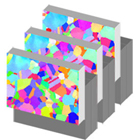Even though you see the slides in
two dimensions, keep in mind it's really a three dimensional world.
- By studying the structures cut
in different planes of section, one can mentally reconstruct
their 3-dimensional appearance and make accurate morphological
interpretation of the structures.
- Elucidation of the complicated
internal organization of certain complex organs and structures
of the body requires the preparation of consecutive (serial)
sections.
Common orientation of a tissue sections.
|
Longitudinal section:
a cut that is parallel to the longest dimension of the
organ or specimen. |
 |
Oblique section: a
cut that is at any angle between the longitudinal and
transverse planes. |
 |
|
Cross, or transverse,
section: a cut that is perpendicular to the main
plane of the organ or specimen |
 |
Tangential section: a
section that only grazes the surface of a spherical
structure. |
 |
|